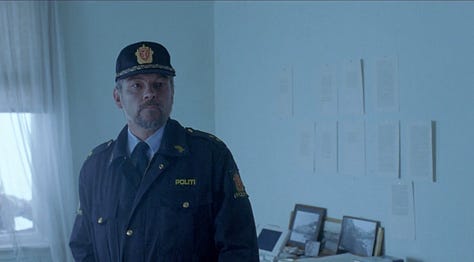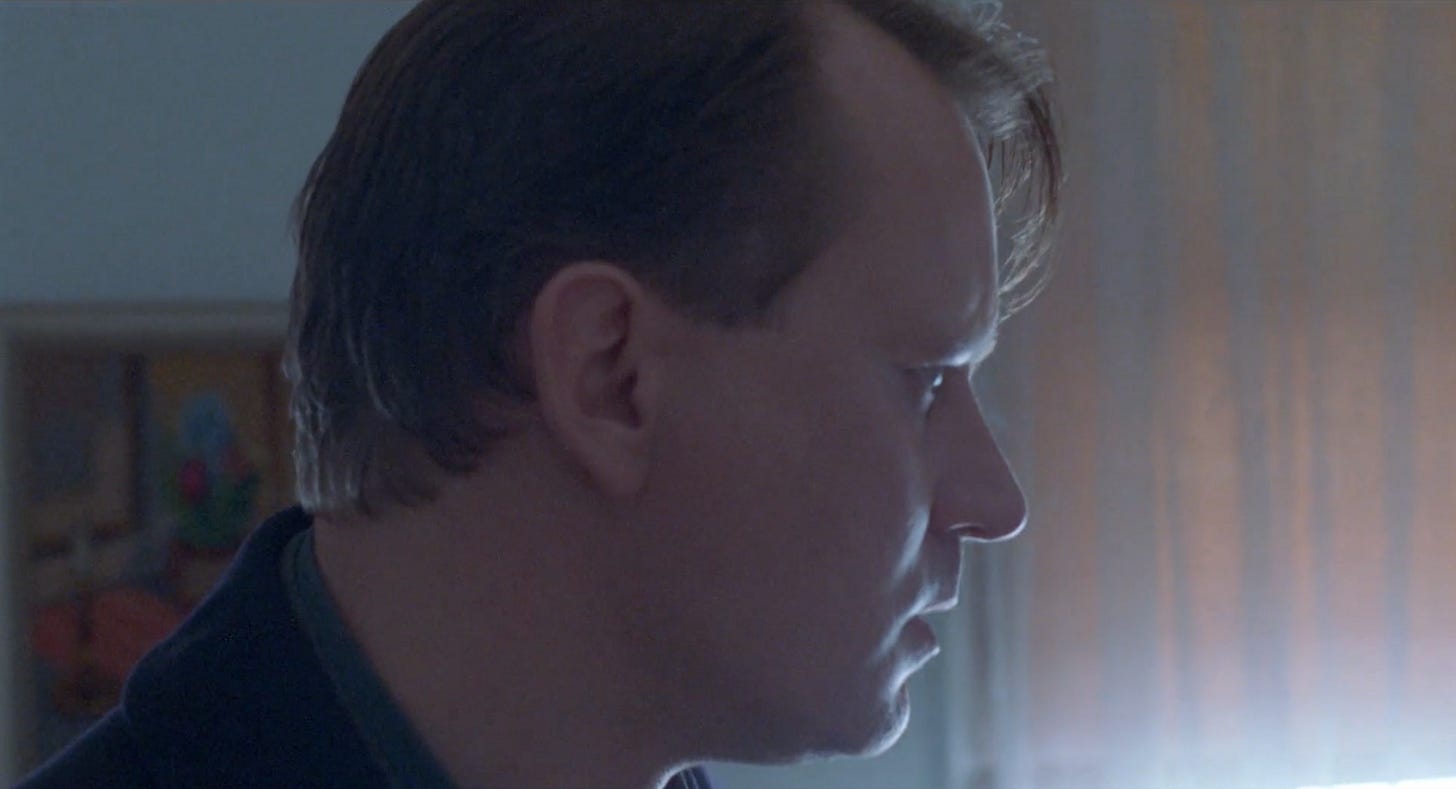Practically Going in Circles: INSOMNIA
We talked about why this oner is so effective, but how do you create that, practically? How do you work with camera and actors to block a scene which 1. is all one smooth, continuous circular shot where 2. characters appear in different places and 3. minor set changes are required.
The short answer is “lots of planning and communication with all department heads.” The detailed answer is below.
‘Leading’ the Camera
When you’re ‘in the scene’ it may feel as though the camera is simply surveying the room. But it feels that way partly because there are so many cues which the camera either moves to, or follows.
At 0:11 a knock sounds; the camera doesn’t immediately move, it holds or ‘thinks’ for a moment, before starting its motion. At 0:19 as it moves past the curtain, we can see Eilert outside knocking and peering in the window, looking not at the body on the couch, but to his left / frame right.
The camera continues its motion towards the direction Eilert is looking, where a cop enters. The camera comes back leftwards with the cop, but when he stops, turns, and looks right, the camera turns towards where he is looking.
As the camera continues its arc, another cop moves into the room (0:31), and the camera follows her until she ‘hands off’ to another cop (0:36) whose motion L-R brings us back to Jonas.





Practical Resets
As the camera moves, there are moving windows of time where resets need to happen: eg. the actor on the couch would have taken the blanket and fluffed the pillows before she ran off set, the actor playing Eilert would have to run around and enter set.
Note when the camera shows the neat couch, it frames out the floor (where scattered games and items would have been much more time consuming to clean up). Because we’re concentrated on the couch, we don’t even notice.




And how does everyone know when they can move?
Offscreen Prompts
If you’re going to layer in all audio later you can have an AD shouting cues — but even then, if an actor needs to be in a specific mindset they may ask for this to be minimised for performance sake.
You can set up visual cues such as “when the grip moves the dolly past the orange X you’re clear to move”), but sometimes the actor can’t see, whether because of angles or here the actor on the couch closes her eyes, and wouldn’t know when she was clear of camera to open then.
So perhaps you need more subtle and specific audio cues, usually involving a complicated network of ‘PAs with walkies crouching in awkward spots and signalling each other and actors.’
Likely a scene like this required a combination of cues. Just like every scene has its own prompt system, each has a hundred unique tiny challenges.
Last Looks
Insomnia has a particular look involving white, bright light throughout; even in scenes which are underground, or where someone trying to sleep has pulled blackout drapes, light creeps through. This scene has several places where light flares into the lens, so the operator having a few passes to know how to handle the camera around those spots is key.
Reflective surfaces are always a killer in scenes like this, whether because they bounce light in ways you don’t want, or they reveal crew crouching in awkward positions. Other than the TV and a few pieces of glass in framed art, there aren’t many mirrors, window closeups, etc. The walk-throughs are also time to carefully tilt the TV and artwork (or using dulling spray on particularly shiny glass) to avoid weird glare, awkward reflections, or hiding reflections you DO want.
Takeaways
While not every oner needs to be ‘led,’ consider how to using audio, eyelines, and motion to invisibly guide the camera through a scene may create the effect you want.
Consider if those impetuses are practical or not; for example the knock could be offscreen within the take, but perhaps for timing purposes you want to decide where it goes in post.
Do several rehearsals and blockthroughs so you catch problems such as reflections or unawanted lighting. Talk through how the offscreen prompts go so everyone is clear, and your actors are all comfortable not just with their cues but their performance, where the camera will be seeing them, etc.
Create one of the more iconic debut films of Norwegian cinema.
Easy!





